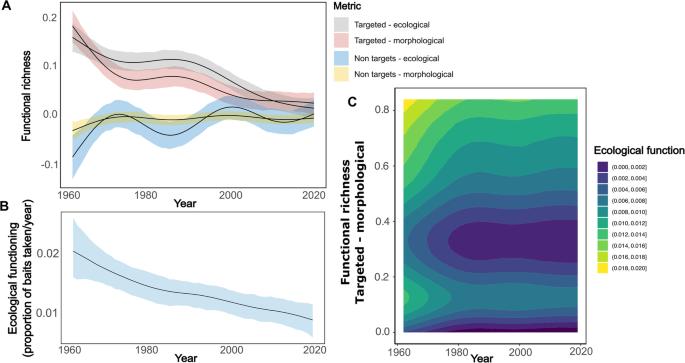Long term declines in the functional diversity of sharks in the coastal oceans of eastern Australia
IF 5.1
1区 生物学
Q1 BIOLOGY
引用次数: 0
Abstract
Human impacts lead to widespread changes in the abundance, diversity and traits of shark assemblages, altering the functioning of coastal ecosystems. The functional consequences of shark declines are often poorly understood due to the absence of empirical data describing long-term change. We use data from the Queensland Shark Control Program in eastern Australia, which has deployed mesh nets and baited hooks across 80 beaches using standardised methodologies since 1962. We illustrate consistent declines in shark functional richness quantified using both ecological (e.g., feeding, habitat and movement) and morphological (e.g., size, morphology) traits, and this corresponds with declining ecological functioning. We demonstrate a community shift from targeted apex sharks to a greater functional richness of non-target species. Declines in apex shark functional richness and corresponding changes in non-target species may lead to an anthropogenically induced trophic cascade. We suggest that repairing diminished shark populations is crucial for the stability of coastal ecosystems. This study illustrates consistent declines in shark functional richness which corresponds with declining ecological functioning and a community shift from targeted apex sharks to a greater functional richness of non-target species.

澳大利亚东部沿海海洋中鲨鱼功能多样性的长期衰退。
人类的影响导致鲨鱼群的数量、多样性和特征发生广泛变化,改变了沿海生态系统的功能。由于缺乏描述长期变化的经验数据,人们往往对鲨鱼数量减少的功能性后果知之甚少。我们使用了澳大利亚东部昆士兰鲨鱼控制项目的数据,该项目自 1962 年以来使用标准化方法在 80 个海滩上布设了网眼和饵钩。我们利用生态(如觅食、栖息地和移动)和形态(如大小、形态)特征量化了鲨鱼功能的丰富性,结果表明鲨鱼功能的丰富性持续下降,这与生态功能的下降是一致的。我们证明了一个群落的转变,从以顶端鲨鱼为目标到非目标物种的功能更加丰富。顶端鲨鱼功能丰富度的下降和非目标物种的相应变化可能会导致人为诱发的营养级联。我们认为,修复减少的鲨鱼种群对沿海生态系统的稳定至关重要。
本文章由计算机程序翻译,如有差异,请以英文原文为准。
求助全文
约1分钟内获得全文
求助全文
来源期刊

Communications Biology
Medicine-Medicine (miscellaneous)
CiteScore
8.60
自引率
1.70%
发文量
1233
审稿时长
13 weeks
期刊介绍:
Communications Biology is an open access journal from Nature Research publishing high-quality research, reviews and commentary in all areas of the biological sciences. Research papers published by the journal represent significant advances bringing new biological insight to a specialized area of research.
 求助内容:
求助内容: 应助结果提醒方式:
应助结果提醒方式:


